Sometimes, to be really great at something, you have to understand its limits. How far can it be pushed before it breaks? How much can it transform before it becomes something else? Nowhere is this truer than in literature, a discipline where there is still no unanimous decision on even the most basic of questions.
When does prose become poetry? Can you write a story without characters? What constitutes a setting?
These questions can seem daunting at times, but for writers they’re also invigorating. Many writers have vastly improved their skills by asking these questions of themselves and trying to produce writing that offers an answer, or even just explores what an answer might look like. Experimenting with the extremes of writing helps build confidence in the more traditional elements, because sometimes it’s only in trying to remove something from a story that you can understand everything it was doing in the first place.
In this article, I’ll be exploring five works of experimental writing, discussing what they try to do and what authors can learn from them. Not all of the books I’ll talk about are heralded as great works, but all of them suggest new ways of looking at writing that can enhance the abilities of even the most experienced writer.
So whether you’re looking for inspiration or just a great Christmas present, strap yourself in, ‘cause things are about to get weird.
#5 Raymond Queneau’s Exercises in Style
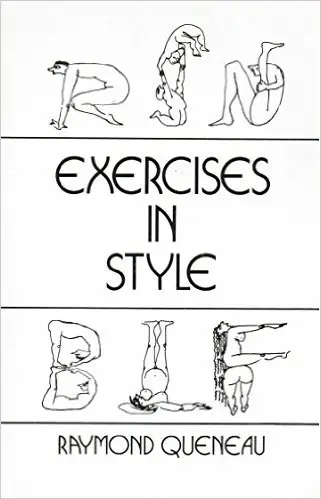 Originally written in French, Queneau’s book has been part translated, part adapted into over thirty languages. It contains ninety-nine versions of the same, very basic story.
Originally written in French, Queneau’s book has been part translated, part adapted into over thirty languages. It contains ninety-nine versions of the same, very basic story.
On a crowded bus at midday, the narrator observes one man accusing another of jostling him deliberately. When a seat is vacated, the first man takes it. Later, in another part of town, the man is spotted again while being advised by a friend to have another button sewn onto his overcoat.
Exercises in Style retells this apparently unremarkable tale ninety-nine times, employing a variety of styles, ranging from sonnet to cockney to mathematical formula.
– Raymond Queneau, Exercises in Style
Generally lasting one to two pages, each retelling does something new with the story. In the ‘Cross-examination’ chapter, the events are recounted as answers to an interrogation. In ‘Comedy’ the scene is written as a play. In ‘Olfactory’ the story is told with an emphasis on the smells the narrator experienced during the events, while in ‘Asides’ the reader is privy to the narrator’s thoughts. In ‘Retrograde’ the story’s events are related in backwards order, while maintaining the same chronology:
I came across him in the middle of the Cour de Rome, after having left him rushing avidly towards a seat. He had just protested against being pushed by another passenger who, he said, was jostling him…
Importantly, not every story is a masterwork, and not every story can stand by itself. In ‘Interjections’, one of the last chapters, Queneau retells the story using only interjected sounds:
Psst! H’m! Ah! Oh! Hem! Ah! Ha! Hey! Well! Oh! Pooh! Poof! Ow! Oo! Ouch! Hey! Eh! H’m! Pfft!
Well! Hey! Pooh! Oh! H’m! Right!
What’s the point?
Exercises in Style makes many individual points about literature, but the main thing writers can take away is the sheer range of choice available to them. Queneau’s presentation of two simple events is effortless, from chapter 1 to chapter 99, and the reader is left in no doubt that he could keep going and going with no more effort.
Queneau reveals the fallacy of limited concepts like choosing between first and third person narration, proving that the choices available to the author don’t number in their twos and threes, but in their hundreds.
What’s more, Queneau shows the reader that the way in which the story is told can transform it, to the point that the same events can be recounted almost one hundred times without growing stale.
Exercises in Style also makes an important point about context. ‘Interjections’ works because the reader is intimately familiar with the narrative, and so Queneau uses the experience to comically focus on one set of details. Here he shows that if the reader can be assumed to know something, the author can pull off tricks that look incomprehensible from the outside.
Queneau’s retellings go on to illustrate points about form, sense writing, metaphor, and a host of other elements of writing too numerous to list here. It’s an example of just how many tools the writer has at their disposal.
Also available is Matt Madden’s 99 Ways to Tell a Story, in which the comic artist picks up Queneau’s challenge and performs ninety-nine visual retellings of his own simple story.
#4 Ernest Vincent Wright’s Gadsby
Ernest V. Wright’s Gadsby is a frequently maligned but much misunderstood example of ‘constrained writing’. Constrained writing is a literary technique where the writer sticks to some kind of condition, set by themselves or others, while writing a text. Wright’s condition for Gadsby was to write a full-length novel without once using the letter ‘E’.
If youth, throughout all history, had a champion to stand up for it; to show a doubting world that a child can think; and, possibly, do it practically; you wouldn’t constantly run across folks today who claim that “a child don’t know anything”. A child’s brain starts functioning at birth; and has, amongst its many infant convolutions, thousands of dormant atoms, into which God has put a mystic possibility for noticing an adult’s act, and figuring out its purport.
– Ernest V. Wright, Gadsby
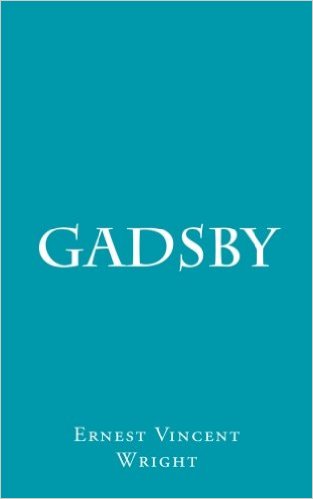 Originally self-published, Gadsby is 50,110 words long and lives up to the goal of its writer, not using ‘e’ once despite it being the most commonly used letter in the language. Most importantly, the writing is smooth and, while phrasing is obviously unique, the reader can read the book straight without missing the banished vowel.
Originally self-published, Gadsby is 50,110 words long and lives up to the goal of its writer, not using ‘e’ once despite it being the most commonly used letter in the language. Most importantly, the writing is smooth and, while phrasing is obviously unique, the reader can read the book straight without missing the banished vowel.
What’s the point?
Every author has struggled with word choice; with not being able to find the right phrase to convey exactly what they mean. Gadsby serves as the answer, showing authors that being able to phrase things ‘just so’ isn’t essential to making yourself understood, or even telling your story well. It pulls back the focus on wording to show that it’s only one part of getting your point across.
Gadsby is also a great introduction to constrained writing, a device which can help writers achieve a whole new level of their craft. The lesson Gadsby teaches isn’t just that even the most extreme constraint can be overcome, but that treating it as a challenge can be an avenue to something better.
Constrained artistry isn’t unique to writing, and those who want to know more about it should check out the movie The Five Obstructions, in which director Lars von Trier challenges his mentor to remake the same film five times under harsher and harsher constraints, one of which is to make it in the worst place in the world without showing that place.
Of course it’s not all about extremes – you could just put a word limit on your sentences, or only allow yourself a certain number of adjectives. The point is to teach yourself to think creatively, and turn a common annoyance in writing into a springboard to greatness.
#3 Randall Munroe’s Thing Explainer
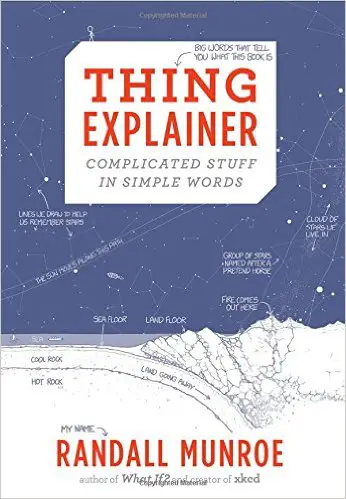 Randall Munroe is a former NASA roboticist and creator of the web comic XKCD. His penchant for whimsy and hard science have often combined, most frequently on his site’s ‘What if?’ page, which provides thorough scientific answers to questions like ‘How many fairies would there be if each fairy is born from the first laugh of a child and fairies were immortal?’
Randall Munroe is a former NASA roboticist and creator of the web comic XKCD. His penchant for whimsy and hard science have often combined, most frequently on his site’s ‘What if?’ page, which provides thorough scientific answers to questions like ‘How many fairies would there be if each fairy is born from the first laugh of a child and fairies were immortal?’
In Thing Explainer Munroe sets out to definitively prove Einstein’s maxim ‘if you can’t explain it simply, you don’t understand it well enough’.
Things are explained… using only drawings and a vocabulary of the 1,000 (or “ten hundred”) most common words. Explore computer buildings (datacenters), the flat rocks we live on (tectonic plates), the things you use to steer a plane (airliner cockpit controls), and the little bags of water you’re made of (cells).
– Randall Monroe, Thing Explainer
Monroe uses this limited pool of words to explain a variety of complex machinery in a way even children can understand.
What’s the point?
Munroe’s work is another example of constrained writing, but it’s also more than that. Thing Explainer doesn’t just manage to explain complicated things with simple words – it makes those things more understandable.
Many writers would struggle to explain the Mars Rover, but Munroe uses his constrained vocabulary to focus on the key concepts behind the machine:
We sent this car to the red world near Earth so it could drive around and look at stuff for us. It’s helping us figure out whether that world ever had seas, and whether those seas could have had life in them.
Here Munroe shows that meaning is more important than phrasing, communicating more efficiently because he’s forced to really examine what he’s trying to say. Thing Explainer is a great advocate for the benefits of constrained writing, but its true value is in forcing authors to confront the idea of communication as separate from vocabulary.
It’s a difficult mindset to embrace, but when authors explore this idea they’ll find that writing issues are given a whole new dimension. It’s far easier to judge the best way to say something when you understand that you’re allowed to say it simply or even not say it at all.
#2 B.S. Johnson’s The Unfortunates
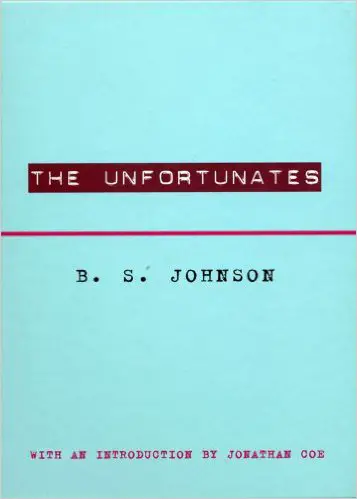 The Unfortunates is a ‘book in a box’, comprised of twenty-seven unbound sections. The sections are unbound so they can be mixed together according to the book’s experimental structure:
The Unfortunates is a ‘book in a box’, comprised of twenty-seven unbound sections. The sections are unbound so they can be mixed together according to the book’s experimental structure:
Apart from the first and last sections (which are marked as such) the other twenty-five sections are intended to be read in random order.
If readers prefer not to accept the random order in which they receive the novel, then they may re-arrange the sections into any other random order before reading.
– B.S. Johnson, The Unfortunates
Johnson removes most of the structure from his story, using the beginning and the end for context. Since the story itself is about memory and mortality the fragmented structure works perfectly – the story is in the interplay of the memories, something that works no matter what order they arrive in.
What’s the point?
Johnson deliberately and meticulously removes almost all need for chronology within his story. This is not just for the challenge of constrained writing, but also because he viewed it as the best way to get his message across.
I continue to believe that my solution was nearer; and even if it was only marginally nearer, then it was still a better solution to the problem of conveying the mind’s randomness than the imposed order of a bound book.
The Unfortunates takes what many assume to be a vital part of a story, its very structure, and asks not just ‘is this necessary?’ but ‘can a story benefit from its absence?’ Even if you don’t think the answer is ‘yes’, The Unfortunates can still open your eyes to the possibility that it might have. By removing structure, Johnson increases the audience’s appreciation of it.
The Unfortunates prompts the reader to ask if the rigid structure of fiction is actually false – something real life never offers – and therefore a barrier to believability. It’s a relatively safe way to explore your own presumptions about the unwritten laws of writing, and shows that the only thing that stands in the way of doing things differently is a writer who can imagine what that might look like.
David Hine and Shaky Kane’s The Bulletproof Coffin: Disinterred takes this idea and runs with it, with one issue of the collection made up of eighty-four panels of art, many of which include speech or narration. Some panels seem to follow each other in a clear narrative, while others could be forced to, or have similarities that invite the reader’s own interpretation. Hine and Kane encourage the reader to cut up the pages and arrange the images in their own narrative, forcing them to confront not just the concept of structure, but that of theme, imagery and even the physical item in their hands.
Here the author is asked to transgress against their own property, destroying something to fully appreciate it, but the last entry on this list is one where the author asks the reader to transgress against the story itself.
#1 Chuck Palahniuk’s Invisible Monsters Remix
Originally an unusual but structurally regular novel, Invisible Monsters benefitted from Palahniuk’s eventual fame when he decided to revisit the text and adjust it to what he claims was its original intent.
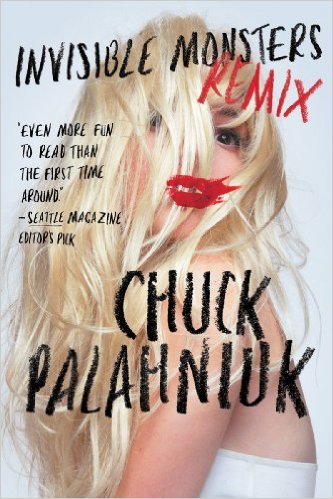 Invisible Monsters Remix chops up the original story, presenting it in short scenes which end with a request to skip to another page. Readers follow the attendant directions, being sent to one page or another and continuing the story from there.
Invisible Monsters Remix chops up the original story, presenting it in short scenes which end with a request to skip to another page. Readers follow the attendant directions, being sent to one page or another and continuing the story from there.
This would be labyrinthine enough, but there are actually hidden sections in the book that readers can’t find without breaking the rules. To get the full story the reader has to abandon the author and go looking, not just party to Palahniuk’s own flouting of physical continuity, but rejecting the shattered path he’s left in its place.
That was my original plan for Invisible Monsters. Even after the reader reached the words “The End” she’d still sense she hadn’t read it all. The book would still hold some lingering secrets… That’s how I originally wrote this book. It was packed with jumps. Hidden secrets. Buried treasure.
What’s the point?
Invisible Monsters Remix takes the ultimate chance for a work of art: that people won’t see it. Palahniuk hides content knowing that not all his readers will encounter it, accepting that the significance this lends the hidden work is worth the trade.
This has to be one of the final taboos of writing, and one that many authors will never dare confront. It encourages writers to think about what they value in a story, and about their own place in their work. If the reader can have a better experience without the author then should the author recuse themselves from the experience?
Even if the answer is no, writers are forced to confront their own continuing influence within their work. This is a blind spot for many authors, but well worth investigating.
In Mark Z. Danielewski’s House of Leaves, multiple authors are credited with writing different parts of the book. Real-life celebrities are attributed with fictional interviews, shadowy editors encroach via footnotes, and eventually a character within the book begins to read a book of the same name. In a novel that plays with what’s real, what isn’t, and how fiction can bridge the gap, it’s a haunting effect, and one only achieved because Danielewski is able to limit his presence and fictionalize much of his efforts.
Invisible Monsters Remix shows writers that this kind of story is possible, not just questioning multiple facets of storytelling but bringing the writer’s attention to their own role and how it can be played with.
Exploring inspiration
As I mentioned earlier, appreciating experimental literature is about finding new ways to understand and appreciate your own writing. That writing might be experimental in its own ways, completely traditional, or somewhere in-between, but it still stands to benefit.
The point is to give yourself options, new ways of looking at the craft of writing that you can use or ignore at your leisure. Understanding how The Unfortunates treats memories as outside chronology can help you craft a more believable backstory for your characters, while the simplicity you witness in Thing Explainer can help cut out verbiage and keep your action scenes crisp.
It’s hard to describe how useful the lessons of experimental literature end up being, but rest assured that a little time invested will pay off big time in your writing. And, if nothing else, at least you’ve now got a fair shot at buying your writer friend something they haven’t read before.
For more on sources of inspiration, check out Eleven places you can find inspiration for your writing, or for something to work on right now check out our writing prompts and this complete guide of how to use them.
Do you have any inspirational novels that do things a little differently, or do you have a project in the works that fits the bill? Let me know in the comments, or contact me via our Let’s talk service for advice and consultation.



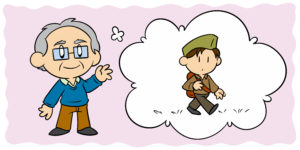

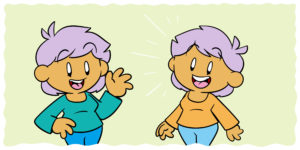
1 thought on “Five Experimental Novels That Will Inspire Any Writer”
extremely inspiring and brilliant interpretations of these complex works. thank you for your very useful contribution to an aspiring literary fiction writer.